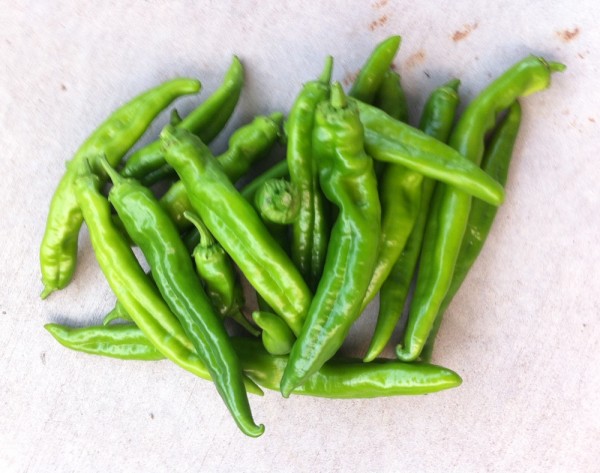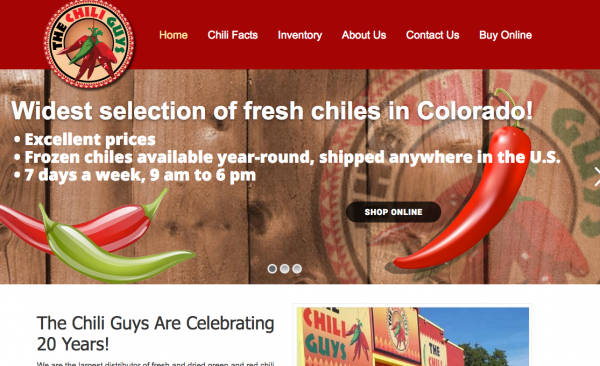The Chile Champ
by Bruce • September 14, 2017 • LifeStuff • 0 Comments
It’s a fair boast.
Pueblo chile peppers can be appetizingly amazing.
They can be “meatier and thicker” than some of their New Mexico counterparts, raised in the cool evening air and loamy soil of southeastern Colorado’s St. Charles Mesa.
There is room enough in the world for a range of good chile pepper regions, because the truth is, people like chile peppers.
Clearly they do in Pueblo, Colorado, where now at the end of each September they enjoy the Chile and Frijole Festival- a weekend fiesta where around 130,000 people congregate to explore and indulge in products related to the area’s prized produce.
Over a century ago, an Italian immigrant decided to try his hand at planting peppers in a plot outside of Pueblo in the Arkansas River Valley east of town, and behold, the plant took. At that time, though, the locals had little use for it.
Jump ahead 60 years or so later, in the 1970’s, and an appetite for Mexican food finally found the little city, and the locals discovered spicy foods were great. But the connection had not yet been made: Pueblo is Colorado’s Pepperville. That wouldn’t emerge for another twenty years or so.
When it finally did, in 1995, when the Pueblo Chamber of Commerce threw their first Chile and Frijole Festival, there was one farmer present with chiles to sell. He sold out of everything he had brought with him, of course, but Pueblo, the Colorado city of chiles, was still in its infancy.
And that was 22 years ago.
Now, granted, Harry Mosco had discovered the Arkansas River Valley east of Pueblo was a prime location to grow peppers, and he farmed some sizable yields before that first festival was a reality.
In time, it would be his nephew, a PhD at CSU-Arkansas Valley, an ag school branch of the university in southeast Colorado, who would take a few of the best crops from his uncle’s farm during the summer of 1992, and begin raising plants so that he could cross-pollinate and improve upon his uncle’s special plant, saving fruit from the most robust and ideal plants from his crops each year so that he could develop a finer fruit suited to the area.
Mike Bartolo named the meatier chile pepper that resulted from his work, developed originally from a sample from his uncle’s unique “Marisol” strain, a Mosco Chile.
The Marisol had a big hand in winning over Pueblo to becoming pepper people. The Mosco gives Pueblans a chile pepper for other growing regions to contend with.
But that history of Pueblo peppers still has a short timeline. Pueblo’s claim as a chile center is earnest, and heartfelt by the locals, but it also probably needs a little time to yet mature.
And Mosco’s Marisol pepper, also called a Pueblo pepper, is also known as the “New Mexico Chile Improved”.
Peppers have been around for a long time, and experts believe that they first grew in Mexico some 6000-9000 years ago.
When the Spanish came to the New World in the 16th century, one of the first items they took back with them to Europe was the curiosity of the pepper. Traders in Lisbon ended up discovering that the plants had demand in Asia. The Spanish discovered that the Aztecs and the other indigenous people they encountered in the New World used the fruit not only for its culinary qualities, but also for its medicinal values. The natives living in the Pueblos up and down the Rio Grande river in the north frontier of New Spain raised the fruits along with their base food crops of corn, beans, and squash. The river valley in the territory seemed suited for raising the peppers. That frontier, in time, would become the New Mexico Territory, slowly inhabited by European settlers in the late 18th and early 19th century when precious metal strikes and farming stakes brought Spanish homesteaders into the region to quietly raise plants and sheep.
Such settlement was not the case in Colorado until the mid-19th century, when homesteading was possible- and a peace treaty was signed between the United States and a marauding Ute Nation in 1850.
The first European settlers in Colorado after that significant event were Hispanic transplants from Taos, New Mexico, who set down in the village of San Luis in southeastern Colorado. In 1851.
And it was not until 7 years later, in 1858, when gold was discovered at Pike’s Peak, and a rush flooded the Colorado Territory with other European hopefuls.
The Pueblos in New Mexico maintained their autonomous identities after the U.S. made the Louisiana Purchase, and Mexico ceded the New Mexico Territory to the young nation. And the Pueblos maintained the status quo, farming their staple foods along the Rio Grande, but joined by the Spanish settlers.
In the late 1800’s, present-day New Mexico State University took a special interest in Southwest-climate agriculture, and specifically in the development of the chile pepper as a regionally significant plant. The work of its researchers, students, and growers led to the development of a hearty cross-bred strain by Fabian Garcia that, in 1921, paved the way for a sizable chile industry in the sate to bloom.
And then Hatch happened. And Jemez peppers. And Chimayo peppers. And other regional peppers that popped up in New Mexico.
The world knows about Hatch Chile Peppers, whether or not they know if the chile peppers used in products labelled as Hatch Chile Peppers are actually from Hatch.
Pueblo grows chile peppers.
Heck, so do farmers in Ecuador, and Mexico, and Australia, and in Asia for that matter.
Today, 35 million tons of chile peppers are produced annually around the world, and China produces nearly half of those peppers- a whopping 48% of the world’s chile peppers, or over 17 million tons of them.
But just as there is something about Pueblo peppers, you young upstarts, there is also something about New Mexico’s ample offerings. A long history of raising chile in the state attests to the importance of the fruit to the region, and the importance of the region to the produce’s identity.
New Mexico has the rightful claim to giving America its love for chile peppers.
Pueblo, your fruits and your festival might be awesome, but I have to think you owe your discovery of the chile pepper, and your state for that matter, to your neighbors in that territory to your south.
Pueblo may have spurred Colorado to produce their specialty chile pepper license plate, but New Mexico has long been America’s chile pepper champion.


